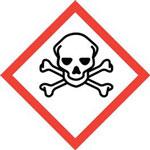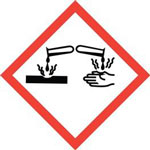Hydrofluoric Acid and Hydrogen Fluoride
- Hazard Summary
- Acute Health Effects
- Other Long-Term Effects
- Before any HF Use
- First Aid Supplie and Response
- Personal Protective Equipment (PPE)
- Good Work Practices
- Disposal and Storage
Hazard Summary
Hydrofluoric acid (HF) and Hydrogen Fluoride (HF) are very poisonous, highly irritating and corrosive. Hydrofluoric acid or Hydrogen Fluoride (HF) is fatal if inhaled, if swallowed, or in contact with skin. It causes severe skin burns and eye damage. The effects may be delayed after exposure. Do not eat, drink, or smoke when using HF. HF is corrosive to metals.
 |
 |
|
Signal Word: Danger |
|
OSHA Hazards: Target Organ Effect. Toxic by Inhalation, Highly Toxic by Ingestion, Highly Toxic by skin absorption, Corrosive
| Acute toxicity, Oral | Category 2 | LD50/LC50 > 5 and ≤ 50 mg/kg bodyweight |
| Acute toxicity, Inhalation | Category 2 | LD50/LC50 > 100 and ≤ 500 ppmV |
| Acute toxicity, Dermal | Category 1 | LD50/LC50 ≤ 50 mg/kg bodyweight |
| Skin corrosion | Category 1A | ≤ 3 min |
| Serious eye damage | Category 1 | ≥ 3% solutions causes irreversible eye effects |
Acute Health Effects
Hydrogen fluoride is an extEHSely corrosive chemical. The vapor or liquid can cause severe corrosion of the skin, nose throat and eyes. Accidental deaths have occurred from single inhalation and splash exposures. Even weak liquid splashes or vapor exposures can cause severe, insidious and exceptionally painful chemical burns that may have a delayed appearance (see Table 1).
Skin Contact: Produces deep and extEHSely painful skin burns which take a long time to heal. Burns from strong solutions are felt immediately but weaker solutions spilled on the skin may not cause pain for several hours (see Table 1). Workers may have finished work and returned home before the pain hits them and they realize that something is wrong. Fingernails not properly scrubbed can be a problem.
Even weak solutions of hydrofluoric acid will rapidly penetrate the skin, destroying the soft tissue and bone underneath. For these reason a neutralizing agent (the calcium gluconate gel), which will also penetrate the skin, needs to be applied after the skin is washed.
HF Concentration |
Time Before Onset of Pain |
| 0 - 20% HF | Up to 24 Hours |
| 20 - 50% HF | 1 - 8 Hours |
| 50 - 70% HF | < 1 Hour |
| > 70% HF | Immediately |
Eye Contact: Hydrofluoric acid fumes can dry out the eyes and cause a burning sensation, redness and secretions. Splashing into the eyes may cause severe and irreversible damage that permanently affects the person's sight.
Inhalation: Fumes are corrosive and irritating to the respiratory tract and all mucosal tissue. Symptoms include lacrimation, cough, labored breathing, and excessive salivary and sputum formation. Excessive irritation causes chemical pneumonitis and pulmonary edema which could be fatal.
Other Long-Term Effects
Fluoride is deposited in the bone (fluorosis), and may cause pain and stiffness in joints and limbs. There is no evidence that hydrogen fluoride exposure causes cancer. There is inconclusive animal data about toxic effects to a fetus.
Before any HF Use
- All people who will be in the room while HF is in use must have completed training. File a training documentation form signed by the trainee and by the supervisor noting the date, topics, and duration of the training. A hazard assessment must be completed as well. EHS’s HF SOP can be used as a template.
- All first aid supplies must be acquired, labeled properly, dated, and assembled in the work area.
- The following information must be available and prominently posted in the work area:
- The location of the HF first aid supplies
- First aid and medical treatment instructions and material safety data sheets for all types of HF present (available as laminated poster from EHS).
- Standard operating procedure for HF use and the associated hazard assessment.
First Aid Supplies and Response
Labs using HF in any concentration should have an HF first aid kit containing, at minimum, the following items:
- Calcium Gluconate 2.5% Gel
- Milk of Magnesia
- Eye wash 1% Calcium Gluconate
Other products are available for treatment of HF exposure. Contact EHS with any questions about HF safety and what would be best to use in specific circumstances.
Immediately call 911 if exposure to HF occurs. While waiting for medical response, the following steps should occur.
- For skin burns:
- Wash the affected area with water for 5 minute
- Apply calcium gluconate gel, 2.5%
- For eye exposure
- Use eye wash to: rinse eye(s) for 5 minutes
- Irrigate with 1% calcium gluconate solution
- For inhalation:
- Move victim to fresh air
- Give oxygen
- For ingestion:
- Do NOT induce vomiting
- Drink water
- Drink Milk of Magnesia
Personal Protective Equipment (PPE)
- Lab Coat or acid-resistant clothing made with 0.4 kg (13 ounce) neoprene or polyvinyl chloride (PVC) with a nylon liner is recommended.
- The eyes should be protected from liquid splashes with goggles, safety glasses, or face shields, as appropriate.
- Chemical resistant gloves
- Appropriate respiratory protection should be worn whenever vapor concentrations exceed permissible limits.
Good Work Practices
As an employee, you must take reasonable care to protect your own safety and the safety of others in your workplace. When you are using hydrofluoric acid:
- Follow your employer's instructions and training in the safe use of the material.
- Use all of the protective equipment and clothing provided.
- Tell your employer about any situation that may be dangerous so that something can be done before an accident happens.
- Report any accidents, spills or leaks immediately.
Disposal and Storage
- Do NOT store any Hydrofluoric acid in glass containers, use ONLY plastic (most manufacturers recommend less than two years).
- Do NOT store any Hydrogen Fluoride cylinders for extended periods of time.
- There is a potential over-pressure hazard with long term storage of carbon steel containers and Hydrogen Fluoride. Hydrogen Fluoride in the carbon steel container reacts very slowly with the iron in the steel to form iron fluoride and hydrogen which builds pressure within the container. Hydrogen Fluoride in carbon steel containers should not be stored for extended periods of time (recommend less than two years). ExtEHSe caution should be taken during the handling of any carbon steel containers storing Hydrogen Fluoride that have been stored for extended periods of time.
- If you suspect you have an old HF cylinder or lecture bottle, contact EHS immediately at (765) 494-0121.
- Submit a Hazardous Materials Pickup Request to EHS to dispose of any unwanted Hydrofluoric Acid or Hydrogen Fluoride.
Campus Safety Contacts

If you see something, say something.
Purdue Police
Phone: (765) 494-8221
Purdue Fire
Phone: (765) 494-6919
Sign up for Emergency Text Messages
Do you want to recognize one of our staff for a job well done? Nominate the staff member(s) for a Bravo Award here!

